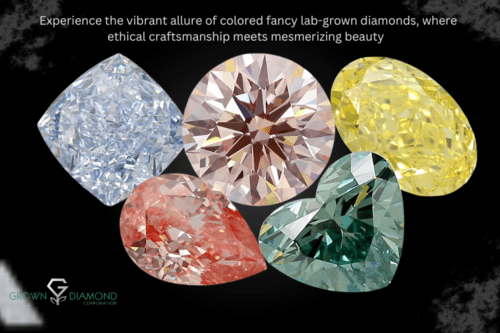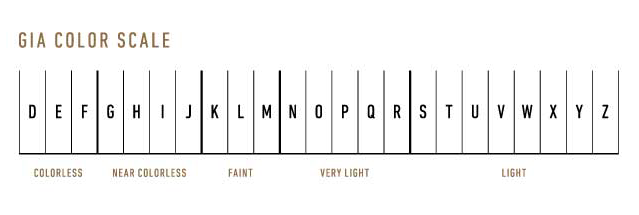A Complete Guide to Understand Colored Diamonds

Color is likely the most familiar aspect of diamond grading, especially for the majority of diamond buyers.
Whether you’re buying diamonds grown in labs or mined diamonds, diamond color is one of the key factors to consider.
But understanding the intricacies of diamond color grading can be perplexing. In this blog, we will share the A to Z of different colored diamonds — from the GIA diamond grading scale to how lab-grown diamond price changes based on color — you’ll learn everything!
What is diamond color?
Diamonds may look colorless to the naked eye, but when examined closely, they have subtle shades. Many think diamonds are clear. But trace elements can give them subtle colors.
Jewelers use the 4 Cs to evaluate diamonds. Among them, color is important mainly for rarity and quality. The utmost rarity is found in completely colorless diamonds, enhancing their value.
Colored diamonds often have yellow, brown, or gray colors. These are due to impurities from the surrounding environment. Evaluating these colored diamonds involves considering hue, tone, and saturation. They form the diamond color scale.
The color of diamonds is graded alphabetically, starting from D. D is considered a perfect color for a diamond. Moving down to E, F, G, H, and so on, the diamond color starts to get yellow or brownish.
The GIA diamond color scale
The Gemological Institute of America (GIA) made the International Color Scale. It aims to make diamond color categories uniform. The grading system is used for mined diamonds as well as diamonds grown in labs. This scale uses a jury system. It carefully judges the color and clarity of each diamond. GIA certification is given only when a five-person jury agrees unanimously on the diamond's grade.
The official GIA diamond color scale uses letters from D to Z. They measure the color in white diamonds. The scale shows the amount of yellow, brown, or gray in the stone. Gemologists scrutinize the color. They do this by placing diamonds face down on white paper. This highlights any imperfections. Diamonds with a D rating are expected to look icy white and colorless. Those with a Z rating may have a noticeable yellow hue. Typically, diamonds falling within the N to Z rating range are not utilized in jewelry.
Here’s a GIA diamond color scale chart that explains the different diamond colors on the scale.

Source
Understanding GIA diamond color grades
Colorless diamonds - D, E and F
Examining different colored diamonds closely reveals subtle differences within categories. This may be hard to see. The colorless grades, namely D, E, and F, may appear quite similar at first glance. However, these nuanced distinctions carry significant implications for the diamond's quality and pricing. For example, colorless lab grown diamond price is slightly more than diamonds that have some color trace.
Diamonds that get a D, E, or F grade are completely colorless. You can only see their color through an electric colorimeter. This is due to the slight variations. To the naked eye, customers typically cannot tell the three clear grades apart. None have distracting yellow or brown hues. As a result, colorless diamonds tend to have similar prices. This is true whether they have a D, E, or F grade.
Near colorless diamonds - G, H, I and J
According to the GIA diamond grading scale, diamonds in the near-colorless range fall within the G to J grades. They have a subtle warmth. But, seeing their color is hard unless they are next to colorless diamonds. Among these grades, the G diamond is popular. This is due to its minimal color and low cost compared to colorless options. Lab grown diamond price of near colorless diamonds is much lesser than mined diamonds of the same quality.
Faintly colored diamonds - K, L and M
As one enters the H grade, diamonds start to show a noticeable hue. A subtle yellow tone becomes visible to the naked eye. Moving on to the I and J grades, the yellow tones become even more apparent than those in the H grade.
Faintly colored diamonds fall within the K to M grades. They have a gentle yellow hue. This tint appeals to those who like it. Faintly colored diamonds have a hint of yellow. They are appreciated for this. They are cheaper than colorless and near-colorless diamonds. The rise of faintly colored diamonds is due to customers. They like the unexpected touch of color. They also like the enduring hardness and durability of diamonds.
Over to you
If you’re looking for different colored lab grown diamonds, you can easily get started by a quick search online. Lab grown diamond manufacturers such as Grown Diamond Corporation offer a range of lab grown diamonds falling in different GIA diamond color grades. And you’ll find all of them on Grown Diamond Corporation’s website.
{"AutoID":133,"DateCreation":"\/Date(1708595303877)\/","DateModified":"\/Date(1718863238447)\/","CreatedBy":null,"ModifiedBy":"Rahul Bohra ","RecordStatus":"A","Title":"A Complete Guide to Understand Colored Diamonds","SubTitle":null,"Description":"\u003cp dir=\"ltr\"\u003eColor is likely the most familiar aspect of diamond grading, especially for the majority of diamond buyers.\u003c/p\u003e\r\n\r\n\u003cp dir=\"ltr\"\u003e\u0026nbsp;\u003c/p\u003e\r\n\r\n\u003cp dir=\"ltr\"\u003eWhether you\u0026rsquo;re buying \u003ca href=\"https://www.growndiamondcorp.com/\"\u003ediamonds grown in labs\u003c/a\u003e or mined diamonds, diamond color is one of the key factors to consider.\u0026nbsp;\u003c/p\u003e\r\n\r\n\u003cp dir=\"ltr\"\u003e\u0026nbsp;\u003c/p\u003e\r\n\r\n\u003cp dir=\"ltr\"\u003eBut understanding the intricacies of diamond color grading can be perplexing. In this blog, we will share the A to Z of different colored diamonds \u0026mdash; from the GIA diamond grading scale to how \u003ca href=\"https://www.growndiamondcorp.com/blog/how-to-determine-the-price-of-your-diamond/\"\u003elab-grown diamond price\u003c/a\u003e changes based on color \u0026mdash; you\u0026rsquo;ll learn everything!\u003c/p\u003e\r\n\r\n\u003cp dir=\"ltr\"\u003e\u0026nbsp;\u003c/p\u003e\r\n\r\n\u003ch2 dir=\"ltr\"\u003e\u003cstrong\u003eWhat is diamond color?\u003c/strong\u003e\u003c/h2\u003e\r\n\r\n\u003cp dir=\"ltr\"\u003eDiamonds may look colorless to the naked eye, but when examined closely, they have subtle shades. Many think diamonds are clear. But trace elements can give them subtle colors.\u0026nbsp;\u003c/p\u003e\r\n\r\n\u003cp dir=\"ltr\"\u003e\u0026nbsp;\u003c/p\u003e\r\n\r\n\u003cp dir=\"ltr\"\u003eJewelers use the \u003ca href=\"https://www.growndiamondcorp.com/blog/the-4cs-of-diamond-grading-all-you-need-to-know/\"\u003e4 Cs\u003c/a\u003e to evaluate diamonds. Among them, color is important mainly for rarity and quality. The utmost rarity is found in completely colorless diamonds, enhancing their value.\u003c/p\u003e\r\n\r\n\u003cp dir=\"ltr\"\u003e\u0026nbsp;\u003c/p\u003e\r\n\r\n\u003cp dir=\"ltr\"\u003eColored diamonds often have yellow, brown, or gray colors. These are due to impurities from the surrounding environment. Evaluating these colored diamonds involves considering hue, tone, and saturation. They form the diamond color scale.\u003c/p\u003e\r\n\r\n\u003cp dir=\"ltr\"\u003e\u0026nbsp;\u003c/p\u003e\r\n\r\n\u003cp dir=\"ltr\"\u003eThe color of diamonds is graded alphabetically, starting from D. D is considered a perfect color for a diamond. Moving down to E, F, G, H, and so on, the diamond color starts to get yellow or brownish.\u0026nbsp;\u003c/p\u003e\r\n\r\n\u003cp dir=\"ltr\"\u003e\u0026nbsp;\u003c/p\u003e\r\n\r\n\u003ch2 dir=\"ltr\"\u003e\u003cstrong\u003eThe GIA diamond color scale\u003c/strong\u003e\u003c/h2\u003e\r\n\r\n\u003cp dir=\"ltr\"\u003eThe Gemological Institute of America (GIA) made the International Color Scale. It aims to make diamond color categories uniform. The grading system is used for \u003ca href=\"https://www.growndiamondcorp.com/blog/can-you-easily-distinguish-between-a-mined-and-a-lab-grown-diamond/\"\u003emined diamonds\u003c/a\u003e as well as diamonds grown in labs. This scale uses a jury system. It carefully judges the color and clarity of each diamond. GIA certification is given only when a five-person jury agrees unanimously on the diamond\u0026#39;s grade.\u003c/p\u003e\r\n\r\n\u003cp dir=\"ltr\"\u003e\u0026nbsp;\u003c/p\u003e\r\n\r\n\u003cp dir=\"ltr\"\u003eThe official GIA diamond color scale uses letters from D to Z. They measure the color in white diamonds. The scale shows the amount of yellow, brown, or gray in the stone. Gemologists scrutinize the color. They do this by placing diamonds face down on white paper. This highlights any imperfections. Diamonds with a D rating are expected to look icy white and colorless. Those with a Z rating may have a noticeable yellow hue. Typically, diamonds falling within the N to Z rating range are not utilized in jewelry.\u003c/p\u003e\r\n\r\n\u003cp dir=\"ltr\"\u003e\u0026nbsp;\u003c/p\u003e\r\n\r\n\u003cp dir=\"ltr\"\u003eHere\u0026rsquo;s a GIA diamond color scale chart that explains the different diamond colors on the scale.\u0026nbsp;\u003c/p\u003e\r\n\r\n\u003cp dir=\"ltr\"\u003e\u0026nbsp;\u003c/p\u003e\r\n\r\n\u003cp dir=\"ltr\"\u003e\u003cimg alt=\"\" src=\"https://emailer.growndiamondcorp.com/blog-images/a-complete-guide-to-understand-colored-diamonds-internal-image.png\" style=\"height:215px; width:639px\" /\u003e\u003c/p\u003e\r\n\r\n\u003cp dir=\"ltr\"\u003e\u003cstrong\u003e\u003ca href=\"https://www.gia.edu/gia-about/4cs-color\"\u003eSource\u003c/a\u003e\u003c/strong\u003e\u003c/p\u003e\r\n\r\n\u003cp dir=\"ltr\"\u003e\u0026nbsp;\u003c/p\u003e\r\n\r\n\u003ch2 dir=\"ltr\"\u003e\u003cstrong\u003eUnderstanding GIA diamond color grades\u003c/strong\u003e\u003c/h2\u003e\r\n\r\n\u003ch3 dir=\"ltr\"\u003e\u003cstrong\u003eColorless diamonds - D, E and F\u003c/strong\u003e\u003c/h3\u003e\r\n\r\n\u003cp dir=\"ltr\"\u003eExamining different colored diamonds closely reveals subtle differences within categories. This may be hard to see. The colorless grades, namely D, E, and F, may appear quite similar at first glance. However, these nuanced distinctions carry significant implications for the diamond\u0026#39;s quality and pricing. For example, \u003ca href=\"https://www.growndiamondcorp.com/blog/all-you-should-know-about-blue-nuance-lab-grown-diamonds/\"\u003ecolorless lab grown diamond\u003c/a\u003e price is slightly more than diamonds that have some color trace.\u003c/p\u003e\r\n\r\n\u003cp dir=\"ltr\"\u003e\u0026nbsp;\u003c/p\u003e\r\n\r\n\u003cp dir=\"ltr\"\u003eDiamonds that get a D, E, or F grade are completely colorless. You can only see their color through an electric colorimeter. This is due to the slight variations. To the naked eye, customers typically cannot tell the three clear grades apart. None have distracting yellow or brown hues. As a result, colorless diamonds tend to have similar prices. This is true whether they have a D, E, or F grade.\u003c/p\u003e\r\n\r\n\u003cp dir=\"ltr\"\u003e\u0026nbsp;\u003c/p\u003e\r\n\r\n\u003ch3 dir=\"ltr\"\u003e\u003cstrong\u003eNear colorless diamonds - G, H, I and J\u003c/strong\u003e\u003c/h3\u003e\r\n\r\n\u003cp dir=\"ltr\"\u003eAccording to the GIA diamond grading scale, diamonds in the near-colorless range fall within the G to J grades. They have a subtle warmth. But, seeing their color is hard unless they are next to colorless diamonds. Among these grades, the G diamond is popular. This is due to its minimal color and low cost compared to colorless options. \u003ca href=\"https://www.growndiamondcorp.com/\"\u003eLab grown diamond\u003c/a\u003e price of near colorless diamonds is much lesser than mined diamonds of the same quality.\u003c/p\u003e\r\n\r\n\u003cp dir=\"ltr\"\u003e\u0026nbsp;\u003c/p\u003e\r\n\r\n\u003ch3 dir=\"ltr\"\u003e\u003cstrong\u003eFaintly colored diamonds - K, L and M\u003c/strong\u003e\u003c/h3\u003e\r\n\r\n\u003cp dir=\"ltr\"\u003eAs one enters the H grade, diamonds start to show a noticeable hue. A subtle yellow tone becomes visible to the naked eye. Moving on to the I and J grades, the yellow tones become even more apparent than those in the H grade.\u003c/p\u003e\r\n\r\n\u003cp dir=\"ltr\"\u003e\u0026nbsp;\u003c/p\u003e\r\n\r\n\u003cp dir=\"ltr\"\u003eFaintly colored diamonds fall within the K to M grades. They have a gentle yellow hue. This tint appeals to those who like it. Faintly colored diamonds have a hint of yellow. They are appreciated for this. They are cheaper than colorless and near-colorless diamonds. The rise of faintly colored diamonds is due to customers. They like the unexpected touch of color. They also like the enduring hardness and durability of diamonds.\u003c/p\u003e\r\n\r\n\u003cp dir=\"ltr\"\u003e\u0026nbsp;\u003c/p\u003e\r\n\r\n\u003ch2 dir=\"ltr\"\u003e\u003cstrong\u003eOver to you\u003c/strong\u003e\u003c/h2\u003e\r\n\r\n\u003cp dir=\"ltr\"\u003eIf you\u0026rsquo;re looking for different \u003ca href=\"https://www.growndiamondcorp.com/blog/colored-lab-grown-diamonds-are-available-in-a-spectrum-of-shades/\"\u003ecolored lab grown diamonds\u003c/a\u003e, you can easily get started by a quick search online. \u003ca href=\"https://www.growndiamondcorp.com/our-story/\"\u003eLab grown diamond manufacturers\u003c/a\u003e such as Grown Diamond Corporation offer a range of lab grown diamonds falling in different GIA diamond color grades. And you\u0026rsquo;ll find all of them on \u003ca href=\"https://www.growndiamondcorp.com\"\u003eGrown Diamond Corporation\u0026rsquo;s website\u003c/a\u003e.\u003c/p\u003e\r\n","FromDate":null,"ToDate":null,"Image_Url":"a-complete-guide-to-understand-colored-diamonds.png","Image_Alt":"Guide to Understand Colored Diamonds","KeyWords":"Diamonds grown in Lab, diamond shape, colored diamonds, lab grown diamond price, gia diamond, different diamond colors, gia diamond grading, gia diamond color scale","MetaDescription":"Learn everything that you need to know about colored diamonds, which is essential for buying colored diamonds. Discover our lab-grown colored diamonds in a variety of hues, cuts, carats, and shapes.","MetaTitle":"A Complete Guide to Understand Colored Diamonds","CanonicalLink":null,"MetaContent":"\u003c!-- Open Graph / Facebook --\u003e\r\n\u003cmeta property=\"og:type\" content=\"website\"\u003e\r\n\u003cmeta property=\"og:url\" content =\"https://www.growndiamondcorp.com/blog/a-complete-guide-to-understand-colored-diamonds/\"\u003e\r\n\u003cmeta property=\"og:title\" content=\"A Complete Guide to Understand Colored Diamonds | Grown Diamond Corporation\"\u003e\r\n\u003cmeta property=\"og:description\" content=\"Learn everything that you need to know about colored diamonds, which is essential for buying colored diamonds. Discover our lab-grown colored diamonds in a variety of hues, cuts, carats, and shapes.\"\u003e\r\n\u003cmeta property=\"og:image\" content=\"https://docs.growndiamondcorp.com/blog/a-complete-guide-to-understand-colored-diamonds.png\"\u003e\r\n\r\n\u003c!-- Twitter --\u003e\r\n\u003cmeta property=\"twitter:card\" content=\"summary_large_image\"\u003e\r\n\u003cmeta property=\"twitter:url\" content=\"https://www.growndiamondcorp.com/blog/a-complete-guide-to-understand-colored-diamonds/\"\u003e\r\n\u003cmeta property=\"twitter:title\" content=\"A Complete Guide to Understand Colored Diamonds | Grown Diamond Corporation\"\u003e\r\n\u003cmeta property=\"twitter:description\" content=\"Learn everything that you need to know about colored diamonds, which is essential for buying colored diamonds. Discover our lab-grown colored diamonds in a variety of hues, cuts, carats, and shapes.”\u003e\r\n\u003cmeta property=\"twitter:image\" content=\"https://docs.growndiamondcorp.com/blog/a-complete-guide-to-understand-colored-diamonds.png\"\u003e","SeqNo":null,"Slug":"a-complete-guide-to-understand-colored-diamonds","GetTitle":"a-complete-guide-to-understand-colored-diamonds","GetImageUrl":"https://docs.growndiamondcorp.com/blog/a-complete-guide-to-understand-colored-diamonds.png"}





